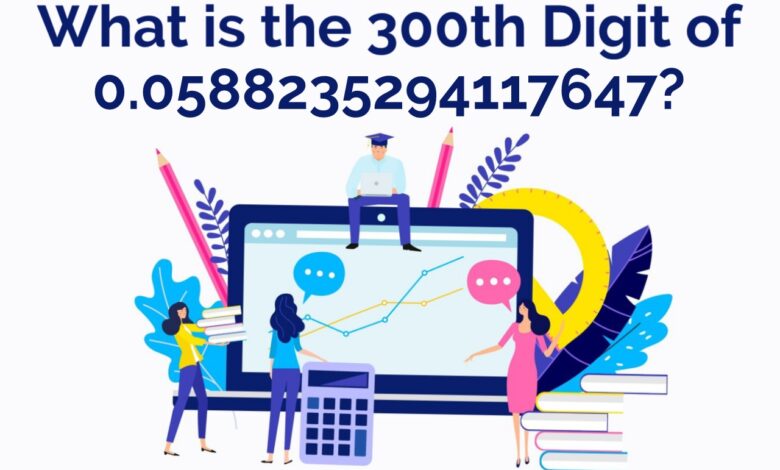
Decimals can be fascinating. While they are commonly used in everyday calculations, exploring specific digits deep within a decimal value can lead to intriguing discoveries. This article takes an in-depth look into the decimal expansion of a particular fraction, 0.0588235294117647, and seeks to uncover what the 300th digit of this number is. In doing so, we will explore both the mathematical properties of repeating decimals and some intriguing techniques for determining the desired digit. So, if you’ve ever wondered how to find such a digit in a long decimal, you’ve come to the right place.
Understanding the Decimal 0.0588235294117647
The number 0.0588235294117647 is the decimal representation of a well-known fraction, 1/17. This fraction produces a repeating decimal, meaning that after a certain number of digits, the decimal pattern begins to repeat itself. Repeating decimals are part of a class of numbers called rational numbers, which are the quotient of two integers (in this case, 1 divided by 17).
When we examine the decimal of 1/17, we notice that the decimal sequence does not go on infinitely without pattern. Instead, the digits after the decimal point eventually start to repeat, forming a repeating sequence. For this number, the sequence that repeats is 0588235294117647, a 16-digit pattern that continues infinitely. Understanding this repeating nature is key to figuring out what the 300th digit of the decimal expansion is.
What is a Repeating Decimal?
Before diving into the 300th digit, it’s essential to understand what repeating decimals are and how they are identified. A repeating decimal, or recurring decimal, is a decimal number that eventually becomes periodic (the same sequence of digits repeats indefinitely). These decimals can either start repeating right after the decimal point or have a delay before the repeating part starts.
In mathematical notation, repeating decimals are often written with a bar over the repeating digits. For example, 0.0588235294117647 can be written as 0.(0588235294117647), where the parentheses indicate the repeating portion. This repeating sequence is finite and predictable, making it easier to locate any particular digit, such as the 300th one.
Why Does 1/17 Produce a Repeating Decimal?
The reason 1/17 produces a repeating decimal is rooted in number theory. When you divide 1 by 17, you get a quotient that does not terminate (end) but instead repeats every 16 digits. This happens because the division of 1 by 17 is exact, with no remainder, which means the decimal representation will never terminate but repeat at regular intervals.
In general, fractions where the denominator has prime factors other than 2 or 5 will result in repeating decimals. In the case of 1/17, since 17 is a prime number, its decimal representation repeats after a certain number of digits. The length of the repeating sequence for 1/17 is 16 digits, making it a cyclic number. This property will help us find the 300th digit without needing to write out the entire decimal.
The Structure of the Decimal 0.0588235294117647
The decimal expansion of 1/17 is unique due to its 16-digit repeating cycle: 0.0588235294117647. This means that after every 16 digits, the decimal repeats itself exactly. The first 16 digits are:
- 0.0588235294117647
Once you reach the end of this sequence, the decimal starts over from 0.05 and continues repeating in the same order. Therefore, the 17th digit is the same as the 1st digit, the 18th digit is the same as the 2nd digit, and so on. This pattern continues indefinitely, making it easy to determine any digit beyond the first 16 digits.
How to Find the 300th Digit of 0.0588235294117647
To find the 300th digit in the repeating sequence of 0.0588235294117647, we need to take advantage of the fact that the decimal repeats every 16 digits. First, we calculate how many complete cycles of 16 digits occur before the 300th digit:
- Divide 300 by 16:
- 300 ÷ 16 = 18 remainder 12
This calculation tells us that after 18 full cycles of 16 digits (which account for the first 288 digits), we are left needing the 12th digit of the next cycle to reach the 300th digit.
Now, we simply look at the repeating sequence of 0.0588235294117647 and find the 12th digit. The sequence is as follows:
- 0 5 8 8 2 3 5 2 9 4 1 1 7 6 4 7
The 12th digit in this sequence is 1. Therefore, the 300th digit of 0.0588235294117647 is 1.
Why This Method Works
The reason this method of division works is due to the periodic nature of repeating decimals. By determining how many full cycles of 16 digits are contained within 300 digits and then finding the position within the next cycle, we can easily pinpoint the 300th digit without needing to write out hundreds of digits. This approach saves time and effort while giving an accurate result.
The Mathematical Significance of Repeating Decimals
Repeating decimals like 0.0588235294117647 offer insight into the relationship between fractions and their decimal representations. The length of the repeating block, known as the period, varies depending on the fraction. For some fractions, like 1/3, the repeating sequence is just one digit long (0.333…), while for others, like 1/17, the period is much longer (16 digits in this case).
The study of repeating decimals connects to other areas of mathematics, such as modular arithmetic and number theory. In fact, the length of the repeating block for a fraction can sometimes be predicted using concepts from these fields. This makes repeating decimals an interesting subject for mathematicians and students alike.
Exploring Other Repeating Decimals
Now that we’ve uncovered the 300th digit of 0.0588235294117647, you might wonder how to find digits in other repeating decimals. The process is essentially the same: first, identify the length of the repeating cycle, then use division and modular arithmetic to determine which digit corresponds to your desired position.
For example, the decimal for 1/7 is 0.142857, which has a repeating sequence of six digits (142857). If you wanted to find the 50th digit of this decimal, you would divide 50 by 6, yielding a remainder of 2. The second digit in the repeating sequence is 4, so the 50th digit of 1/7 is 4.
Practical Applications of Repeating Decimals
While finding specific digits in a decimal expansion may seem like a purely mathematical exercise, repeating decimals have practical applications in various fields. For example, repeating decimals are used in:
- Cryptography: The periodic nature of certain decimal sequences can be harnessed in encryption algorithms.
- Computer Science: Decimal expansions are important in numerical analysis and computer algorithms, where precision is crucial.
- Financial Calculations: Repeating decimals appear in interest rate calculations, especially in cases of compound interest.
Understanding how to work with repeating decimals can help in these fields, providing insights into patterns and relationships within numbers.
Read More: Brookstone AR108A4BKA: The Ultimate Gadget for Comfort and Convenience
Conclusion
The 300th digit of 0.0588235294117647 is 1, a result that can be determined by understanding the repeating nature of the decimal expansion of 1/17. By breaking the problem down into manageable steps—identifying the repeating sequence and using modular arithmetic to locate the desired digit—we can quickly and efficiently find any digit within a repeating decimal.
Repeating decimals, though seemingly simple, offer a glimpse into the fascinating world of mathematics and number theory. Whether you’re studying math, working in a field that requires precision with numbers, or just curious about the structure of decimals, understanding how to find specific digits in repeating sequences is a valuable skill.
In the case of 0.0588235294117647, the repeating block of 16 digits provides a clear pattern, allowing us to pinpoint the 300th digit with ease. As you explore other repeating decimals, you’ll find that the same principles apply, making this an exciting and rewarding area of study.



